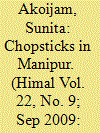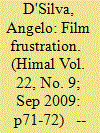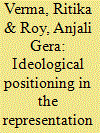| Srl | Item |
| 1 |
ID:
090560


|
|
|
|
|
| Publication |
2009.
|
| Summary/Abstract |
In September 2000, a separatist group known as the Revolutionary People's Front banned the screening of Hindi films in the state, along with the distribution of all Hindi satellite channels. Terming Hindi films to be a form of cultural imperialism, the group said that Bollywood was undermining the culture of Manipur. Soon there was no trace of Hindi films, television serials, song sequences or even songs on radio stations in Manipur. Except for the government-controlled Doordarshan, all satellite channels broadcasting Hindi films and Hindi serials quickly disappeared.
|
|
|
|
|
|
|
|
|
|
|
|
|
|
|
|
| 2 |
ID:
090569


|
|
|
|
|
| Publication |
2009.
|
| Summary/Abstract |
A curious incident struck Nepali cinemas on 22 January. After barely a few days on screens, the government of Nepal pulled the Bollywood movie Chandni Chowk to China from theatres, purportedly for offending the Nepali public by briefly suggesting that India was the land of the Sakyamuni Buddha's birth. The claim was contained in dramatic narration studded within a cinematic blizzard of depictions of Delhi a scarce minute into the movie. Arguably, it might have been employed in order to juxtapose India with China, the eponymous destination of the movie.
|
|
|
|
|
|
|
|
|
|
|
|
|
|
|
|
| 3 |
ID:
186889


|
|
|
|
|
| Summary/Abstract |
Ideology and cinematic representation are crucially linked even though a film’s positioning of itself with respect to dominant state ideology may differ thus contesting the idea that films always serve as ideological state apparatus. In this context, the paper reflects on the complex ways in which the ideological positioning – advertently or inadvertently – of cinematic representations of Partition in Hindi films of the 2000s interacts with dominant state ideology to frame the relationship between self and other with the terms denoting India/Hindu and Pakistan/Muslim, respectively. Through an analysis of the representation of the India–Pakistan border in four films – Pinjar (2003), Veer-Zaara (2004), Uri: The Surgical Strike (2019) and Kya Dilli Kya Lahore (2014) – the paper argues that mainstream Hindi films are largely reflective of the state ideology, although to varying degrees and at times in spite of themselves. In contrast, a low-budget film as Kya Dilli Kya Lahore completely subverts the dominant ideology through its sensitive but incisive critique of the border.
|
|
|
|
|
|
|
|
|
|
|
|
|
|
|
|